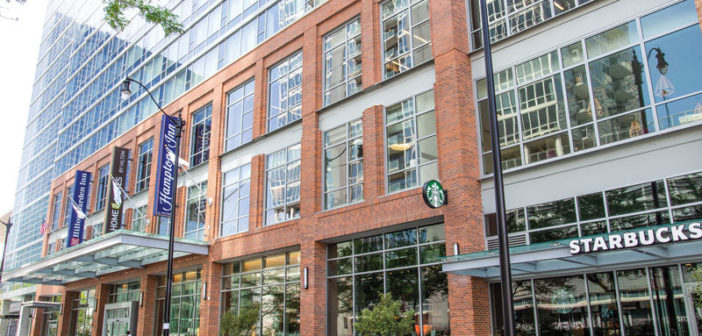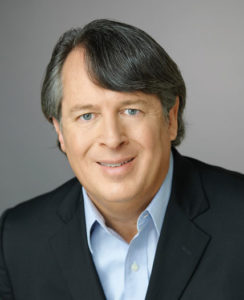CHICAGO—Hilton has opened its first tri-branded property here, and although it doesn’t have any other tri-branded properties currently in its pipeline, the McLean, VA-based hospitality giant is open to other potential project opportunities from within the industry.
“Hilton is very strategic in our development process,” said Bill Duncan, global head of the all suites and focused-service categories at Hilton. “When an owner comes to us with a potential location, we work with them to carefully vet it and determine the hotel brand(s) that make the most sense for the unique dynamics of the individual market.”
The opportunity to develop the property arose after hospitality management and development company First Hospitality Group (FHG) reached out to Hilton with the idea. “We knew it was too perfect of an opportunity to pass up,” he said. “FHG had been a tremendous partner for us in the past and McCormick Place is a premier hub of international commerce that attracts nearly three million visitors a year.” For Hilton, the 23-story hotel project would be the first hotel of its kind in its 14-brand portfolio of more than 5,400 properties with nearly 880,000 rooms in 106 countries and territories.
“Hilton was already an industry leader in the innovation of dual-branded properties, and it was a natural next step for us to build our first tri-branded property,” he said.
Currently, Hilton has a footprint of 84 dual-branded properties across the globe—with multi-branded properties open or in the pipeline in the United States, Canada, Europe, Asia, Latin America and the Middle East.
“FHG has a long history of success and collaboration with the Hilton brand family,” said Stephen Schwartz, FHG chairman and CEO. “In partnership with the brand, FHG has been afforded the flexibility to develop cutting-edge projects like our Hilton Garden Inn Louisville Downtown, featuring custom, local artwork in every room and one of the city’s hottest rooftop bars, or the one-of-a-kind soft branding experience curated at our Hampton Majestic in Downtown Chicago, directly attached to the CIBC Theatre. For all these reasons and more, we felt confident pursing Hilton as our brand partner for this innovative project.”
After agreeing to take on the project, the company then decided on the following brands for the project: Hilton Garden Inn, Hampton by Hilton and Home2 Suites by Hilton. “All three brands are leaders in their respective segments, and their collective range of services and offerings gives guests a diverse set of lodging choice all under one roof, whether they are traveling for business or leisure and staying for one night or an extended stay,” Duncan said.
The property also needed to be able to deliver “thoughtful guest service and unique, value-added amenities that would complement each other and enhance the overall guest experience together,” he added.
The total room breakdown for each Hilton brand on the 379,500-sq.-ft. property—which is owned and managed by FHG—is as follows: 184 Hilton Garden Inn rooms, 187 Hampton Inn rooms and 95 Home2Suites suites.
“When it comes to pairing brands, the goal is to always work together as a company to match the right brands with the right trip occasion for guests and the right investment opportunity for owners and developers,” Duncan said.
Officially named the Hilton Garden Inn Chicago McCormick Center, the Hampton Inn by Hilton Chicago McCormick Center and the Home2 Suites by Hilton Chicago McCormick Center, the hotel broke ground in January 2017 with the help of FHG; a joint venture between James McHugh Construction Co., UJAMAA Construction Inc. and Merritt Development Group; Antunovich Associates; Todd Halamka + Partners; and Looney Associates. Connected to McCormick Place, North America’s largest convention center, by a skybridge, and adjacent to Wintrust Arena, the property opened in August 2018.
“In addition to its convenience for convention-goers, the property is located in Downtown Chicago’s bustling Loop, featuring tourist destinations like the Magnificent Mile, world-class theaters and Millennium Park,” he said. “Moreover, this tri-branded hotel provides a convenient one-stop shop for business and leisure travelers alike to rest and recharge from a busy day or enjoy the local flavors of Chicago, all while remaining just steps from their convention events.”
For the project, total development costs hit $150 million. “Given the intricate vision and scope of the project, our team wasn’t seeking out opportunity to cut costs,” Schwartz said. “Hotel ownership has been committed to putting all possible resources behind these hotels to make the development a resounding success.”
Post development, for owners of multi-branded properties, there are cost savings and operational efficiencies. “The model maximizes resources, minimizes costs and allows them to pool the resources put forth by each distinct brand’s support team, all while allowing owners to target multiple guest segments,” Duncan said. “In short, the unprecedented construction of this tri-branded property delivers a very unique value proposition to FHG and guests alike.”
The entire property’s amenities include an expanded exercise room, an indoor pool, a 24-hour business center and 10 meeting rooms, totaling nearly 7,000 sq. ft. Of course, there are several dining options, too, including VU Skyward Bev & Eat; Fatpour Tapworks; and Starbucks.
Despite not having any tri-branded properties elsewhere, Hilton—based on its research and experience with dual-branded properties—believes urban markets could benefit greatly from tri-branded hotels. “Guests traveling with larger groups or extended families can appreciate enhanced common areas and amenities, preferred room types, and varied price points all under one roof,” Duncan said. “The tri-branded property model also allows us to increase our market share in Chicago in an economically efficient fashion, offering loyal guests of Hilton Garden Inn, Hampton by Hilton and Home2 Suites by Hilton another hotel option in a top-tier market.”
At the moment, the hospitality company is considering major cities globally for future tri-branded sites.
“While we don’t currently have another tri-branded property in the pipeline, as a leader in the development of multi-brand properties, we are open to the development of additional tri-branded properties in any market where the model is the right fit for the location,” he said.
As for what Hilton would do differently next time, it’s difficult to say—every market has its own needs, Duncan said. “Part of Hilton’s success is carefully pairing brands with destinations that make sense for owners and customers,” he said. “Each future property will be carefully planned and evaluated on a case-by-case basis to best serve our owners and future guests,” he said.
FHG has received “incredibly positive feedback so far from guests,” Schwartz said.
This property provides the ownership and management company with an opportunity to educate and shape the consumers’ idea of what a tri-branded hotel is.
“As we weave together this story of three powerhouse brands, two unique restaurants, and an on-site Starbucks under one roof—all directly attached to the McCormick Place Convention Center—we get to experience the eagerness and excitement that comes to life in our guests,” he said. “So, as it has come to fruition, the tri-brand concept has been very warmly embraced.” HB



